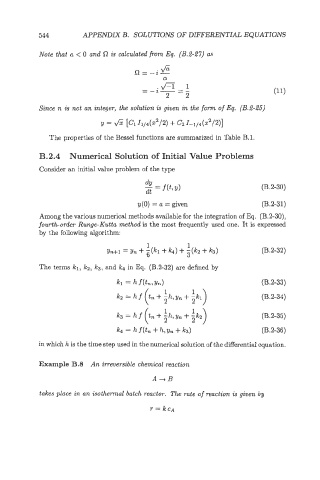Page 564 - Modelling in Transport Phenomena A Conceptual Approach
P. 564
544 APPENDIX B. SOLUTIONS OF DIFFERENTTAL EQUATIONS
Note that a < 0 and R is calculated from Eq. (B.2-27) as
Q=-i- 6
Q
Since n is not an integer, the solution is given in the form of Eq. (B.2-25)
Y = 6 [ci 1i/4(z2/2) + c2 1-i/4(X2/2)]
The properties of the Bessel functions are summarized in Table B.l.
B.2.4 Numerical Solution of Initial Value Problems
Consider an initial value problem of the type
(B.2-30)
y(0) = a = given (B.231)
Among the various numerical methods available for the integration of Eq. (B.2-30))
fourth-order Runge-Kutta method is the most frequently used one. It is expressed
by the following algorithm:
1 1
Y~+I = Yn + g(kl+ k4) + s(k2 + k3) (B.2-32)
The terms kl, k2, k3, and k4 in Eq. (B.2-32) are defined by
(B .2-33)
(B.2-34)
(B.2-35)
(B.2-36)
in which h is the time step used in the numerical solution of the differential equation.
Example B.8 An irreversible chemical reaction
A+B
takes place in an isothermal batch reactor. The rate of reaction is given by
r=kCA

